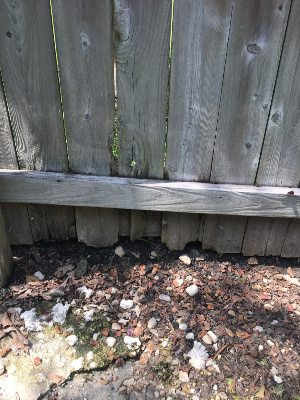Wood Fence Decay – Causes and Cures


Importance of Moisture Content
These pictures are from a wooden fence in my backyard. The fence was present when I moved into my house in 1997. The fence is likely southern pine wood. The end tags are gone so I would need to assay the wood to determine the preservative.
The area of most concern for any exterior wood member is the groundline. For example, when a utility pole is inspected in service for possible remediation or repair the poles are closely examined from top to bottom but with particular emphasis placed on the area immediately above and below the groundline. This area is of concern because the wood moisture content is highest in this area so this area is of greatest risk of decay. Most wood destroying fungi thrive at elevated moisture contents, particularly over 30 percent on an oven dry basis.
My fence boards are all above ground but many of the same principles apply as for poles. The bottom of the fence boards are near the ground. In south Louisiana, we get a lot of rain and a lot of hot and humid days which are ideal for fungi growth. I keep my side of the fence mowed and free of debris. However, my neighbor has several inches of leaves piled against the fence. The leaves will hinder the boards from drying and keep the bottom of the fence boards in a virtual “ground contact” setting.
Extending Service Life
One option for extending the life of a wooden fence is an annual application of a water relent preservative. I try to do this after I have pressure washed the fence and allowed it to dry. I try to select one that offers UV protection.
If wood decay is in the early stages, then I use a remedial preservative such as Bora-Care or Copper Napthenate. Bora-Care and Copper Napthenate preservative are classified as general use by the United States Environmental Protection Agency (EPA) under the Federal Insecticide, Fungicide and Rodenticide Act (FIFRA). Both have a long history of safe and effective use by the pest control industry and are standardized by the American Wood Protection Association (AWPA).
Borates (borax, boric acid, disodium octaborate tetrahydrate (DOT), sodium borate, (SBX)) are inorganic boron-based biocides, generally formulated as a mixture of borax and boric acid into a waterborne system. Borates have extremely low mammalian toxicity and a broad range of activity against decay fungi and insects. They are not corrosive to metal fasteners, are colorless and odorless, paintable once the treated wood is dried and are inexpensive and readily soluble in water. However, their water solubility limits applications to those with minimal or no leaching potential.
Copper Naphthenate is an excellent preservative choice for both pressure and non-pressure treatment of wooden posts and fence boards. The use of copper naphthenate as an industrial biocide and wood preservative has been well established since the turn of the century. Copper naphthenate is basically the metallic salt of a metal ion reacted with naphthenic acids. Trade names for copper naphthenate in commercial use include Perm-E8, Cop-R-Nap, CuNap8, Cunapsol, and Cuprinol.
Meet the Author
Dr. Todd Shupe is the President of Wood Science Consulting, LLC. He is a well-recognized expert on wood forensics, wood preservation, wood decay and degradation, and wood species identification. He has a broad background in new product development, quality management, and marketing and sales in both the public and private sectors. For more information please visit DrToddShupe.com.
We welcome your comments below.
Thank you for visiting. We trust that you have enjoyed reading our articles.
Liked this post? Read more below or search for more topics . . .

